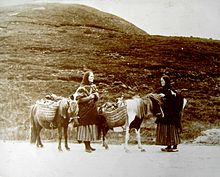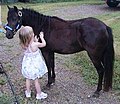Shetland pony
| Shetland pony | |
|---|---|

|
|
| Important data | |
| Origin: | Shetland Islands |
| Main breeding area: | England |
| Distribution: | Europe, USA, in Germany approx. 650 breeding stallions and approx. 3000 broodmares |
| Stick measure : | 87–107 cm (CH: no lower limit; upper limit: 107 cm) |
| Colors : | all (tiger piebalds are prohibited in breeding) |
| Main application area: | Children's and driving pony, utility pony, show pony |
The Shetland pony originally comes from the Shetland Islands . The animals were during the industrial revolution to the British brought the mainland and there in mining underground as pit ponies used. Today the sturdy ponies enjoy great popularity as the first riding horses for children as well as strong and persistent driving horses.
Background information on horse evaluation and breeding can be found under: Exterior , interior and horse breeding .
Exterior
The Shetland pony has a relatively large head with a broad forehead, an almost square mouth, large nostrils and small ears on a strong neck. The legs are short and strong, with clear joints and hard hooves. It often has a dense tail, also often a dense mane with a thick forelock, and in winter it has a dense fur and light hangings on the fetters and lower jaw. The Shetland pony should be a maximum of 107 cm, the mini Shetland pony only 87 cm. Badges are rare. All colors except tiger piebald are allowed. Shetland pony breeders who breed tiger piebalds call these Appaloosa ponies.
interior
In relation to their height, Shetland ponies are among the strongest horses of all, a trained Shetland pony can pull twice its weight. As a rule, Shetland ponies can carry up to 60 kg. They used to be used in agriculture , after the abolition of child labor , especially in Great Britain, they were also used as pit horses in mining, where they were still to be found in the 1930s. Today these ponies can often be found as riding ponies for children or as persistent and powerful draft horses and in the circus . Shetland ponies are frugal and very robust, they are considered intelligent and long-lived. They are late ripe and their life expectancy is often around 40 years.
Breeding history
The Shetland pony is native to the Shetland Islands archipelago. The islands have an extremely maritime, humid climate with winters and cool summers that are comparatively mild for their latitude. Heavy rain, storms and fog are very common. As a result of the unfavorable climate and soil conditions, a selection took place on the islands, which led to small, resistant ponies. In the Ice Age, the islands were connected to one another because of the 100 m lower sea level, but had no connection to the mainland. Therefore, no wild horse finds are known from the Shetlands. Primeval people did not settle for the same reason. The Shetland Islands have been inhabited since the Stone Age. The first horses were believed to have been introduced by the Picten , who came to Scotland from around 500 BC. According to pictures from that time, these horses were very different, sometimes larger than the Shetland pony and were often shown in tölt .
In the Paleolithic Age , wild Shetland pony-type horses were widespread in northeastern Scotland ( Caithness ). At the time of the Roman occupation (1st – 4th centuries AD), a Shetland pony-type dwarf horse was widespread in Scotland. It is very likely that the Shetland ponies are descended from these Scottish dwarf horses. In any case, it has been proven that horses were already present on the Shetland Islands in pre-Norman times. Early Iron Age ponies were less than two feet tall. When the Norwegian / Danish Normans conquered the Shetland Islands between the 8th and 11th centuries, they also brought larger horses with them from their homeland, whose influence can no longer be seen in the modern Shetland pony. The ponies of that time were sometimes over 112 cm tall.
In the Middle Ages, the Shetland ponies were known as Sheltties. Around 1700 they were 91–102 cm tall, the smallest lived on the northern islands of Yell and Unst . Initially, these ponies had no meaning outside the archipelago. It was not until the middle of the 19th century that they were used as pit horses because of their small size. The prices therefore rose from £ 5 to £ 35 between 1840 and 1890.
Shetland pony breeding remained free from foreign blood influences until around 1950. Since the larger ponies were easier to sell, the smaller ponies remained on the island as a breeding base. As a result, the ponies were smaller in 1940 than they were in 1910. So around 1950 several larger horses were introduced to counter this trend. Most of the offspring died because their constitution was not hard enough for the climate. Exceptions to this rule are the Sumburgh tribe and the Fetlar tribe. On the Sumburgh peninsula, which belongs to the main island Mainland , the Sumburgh tribe with a height at the withers of about 130 cm was created through the crossing of Norwegian fjord horses. The more elegant and faster Fetlar line of the island of Fetlar, with a height at the withers of about 125 cm, was created by successfully crossing a Mustang stallion and an Arab.
Lord Londonderry began to breed the original type of Shetland pony on the Bressay stud in 1870. His stud was closed in 1899, but the animals were kept for Shetland pony breeding. Ponies from this breed formed the basis of numerous pure breeds outside the Shetland Islands.
The stud book of the Shetland Pony Stud Book Society was founded in 1890 and closed in 1971, since then pure breeding has continued.
Related breeds
- The only difference between the mini Shetland pony and the Shetland pony is the height of the stick: it has a maximum height of 87 centimeters. It is usually compact, but also elegant in stature and comes in all colors.

- Due to their small size, Shetland ponies have significantly influenced the miniature horse breeds , such as the Falabella (up to 76 cm) and the American Miniature Horse (up to 86.5 cm).
- The American Shetland Pony comes from Shetland ponies from the Shetland Islands, which were imported into the USA from the 19th century. From this a more elegant riding, show and driving pony was bred. The breed officially emerged in 1888. The first studbook appeared in 1891.
- The German Classic Pony is a breed that is derived from the “American Classic Shetland” via the founding stallion “Jiggs”.
- Since no tiger piebalds and no Shetland ponies of the sporty type are permitted in the English dam book, the own breed, German Part-Bred Shetland Pony, was founded in 1999 . The following breeds are permitted for breeding: Shetland pony, Nederlands Mini Paarden, Nederlands Appaloosa Pony (Mini-Appaloosa) and British Spotted Pony.
- The Nederlands Appaloosa Pony (Mini-Appaloosa) is a separate, recognized breed with its own studbook only in the Netherlands. In the remaining countries the animals are listed in the stud books of the German Classic Pony and the German Part-Bred Shetland Pony. Mini Appaloosas are not as stocky as original Shetland ponies, as some Falabellas were crossed. Only tiger piebalds can be entered in the “Nederlandse Appaloosa stamboek” in the main register. Single-colored ponies can only be entered in the register of the association.
- The Nederlands Mini Paarden is also a Shetland pony from the Netherlands. There are two breeding directions. One breed is ultimately pure-bred original Hetland ponies. In the other, various other similar pony breeds are also permitted as parent animals.
See also
literature
- Volkmar Hallensleben and Johannes Erich Flade: Shetland ponies in Germany - history, stallion lines, stud farms. Verlag Sandra Asmussen, Gelting 2001, ISBN 3-935985-08-8 .
- Martin Haller: The British Pony Breeds - All ponies from England, Scotland, Wales & Ireland. Verlag Sandra Asmussen, Gelting 2006, ISBN 3-935985-26-6 .
- Johannes Erich Flade: Shetland ponies. (= Die Neue Brehm-Bücherei. Volume 243). 7th, supplemented edition. Westarp Sciences, Heidelberg 1996, ISBN 3-89432-168-7 .
- Johannes Erich Flade and Karlheinz Gleß: Small horses. 3rd, revised edition. VEB Deutscher Landwirtschaftsverlag, Berlin 1989, ISBN 3-331-00153-8 .
Web links
- Swiss Shetland Pony Association (SSPV) The recognized breed book for Shetland ponies in Switzerland
- Swiss Association for Ponies and Small Horses (SVPK) - Shetland Pony Section - has been keeping the stud books for Switzerland since 1967
- The Shetland Pony Stud-Book Society
- Interest group of Shetland pony breeders in Germany
Individual evidence
- ↑ Dorothee Dahl, Shetlandponys, Cadmos, Lüneburg, 2001, ISBN 3-86127-363-2 , p. 78
- ↑ The Brockhaus in 15 volumes, FA Brockhaus, Leipzig a. Mannheim, 1999, ISBN 3-7653-2931-2 , keyword: Shetland Islands










